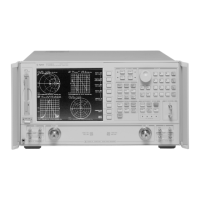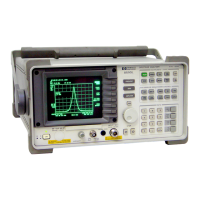8-16
Preset State and Memory Allocation
Memory Allocation
Storing Data to Disk
You can use the internal disk drive or connect an external disk drive for storage of
instrument states, calibration data, measurement data, and plot files. (Refer to the
“Printing, Plotting, and Saving Measurement Results” chapter in the user’s guide for more
information on saving measurement data and plot files.)
The analyzer displays one file name per stored instrument state when you list the disk
directory. In reality, several files are actually stored to the disk when you store the
instrument state. Thus, when the disk directory is accessed from a remote system
controller, the directory will show several files associated with a particular saved state.
The maximum number of files that you can store on a disk depends on the directory size.
You can define the directory size when you format a disk. For the default directory size for
floppy disks and hard disks, refer to Table 8-1.
The maximum number of instrument states and calibrations that can reside on a disk is
limited by the available disk space. To see the available disk space displayed on the
analyzer, press . (Be sure you have selected either or
depending on your disk type.) In the upper right-hand portion of the
display, the value displayed as Bytes free: is the available disk space. If your disk is
formatted in LIF, this value is the largest contiguous block of disk space. Since the
analyzer is reporting the largest contiguous block of disk space, you may or may not see
the bytes free number change when you delete files. If your disk is formatted in DOS, the
number reported as bytes free is the total available disk space. That number is updated
whenever you save to or delete files from the disk.
A disk file created by the analyzer appends a suffix to the file name. (This is on the
analyzer's directory and is not visible.) The suffix consists of one or two characters: the
first character is the file type and the second is a data index. (Each suffix character is
defined in Table 8-6.)
Save/Recall

